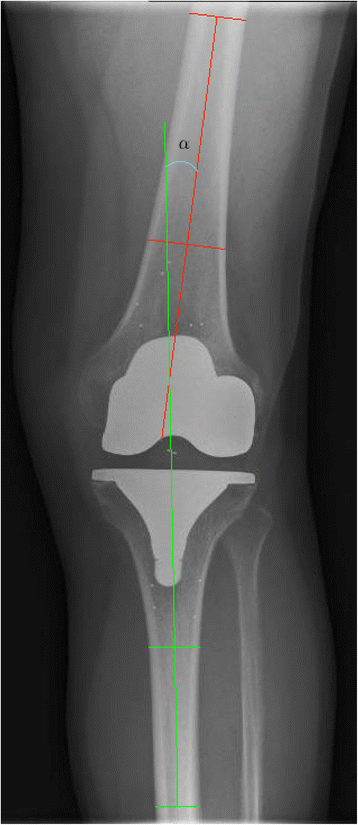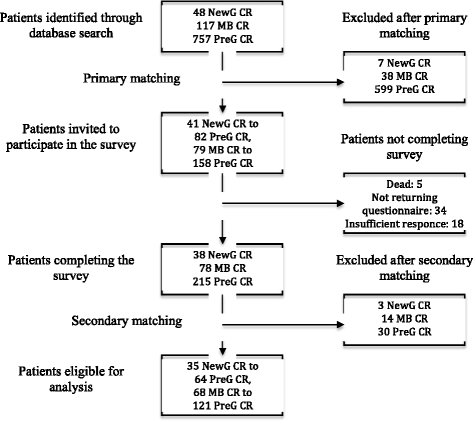Does knee awareness differ between different knee arthroplasty prostheses? A matched, case-control, cross-sectional study
- PMID: 27036995
- PMCID: PMC4818449
- DOI: 10.1186/s12891-016-1001-3
Does knee awareness differ between different knee arthroplasty prostheses? A matched, case-control, cross-sectional study
Abstract
Background: Low knee awareness after Total Knee Arthroplasty (TKA) has become the ultimate goal in trying to achieve a natural feeling knee that meet patient expectations. To accommodate this manufacturers of TKAs have developed new prosthetic designs that potentially could give patients a more natural feeling knee during activities. The purpose af this study was to compare the Forgotten Joint Score (FJS) and Oxford Knee Score (OKS) of patients treated with a previous generation standard Cruciate Retaining (CR) TKA to the scores obtained by patients treated with a newer generation CR TKA or a mobile bearing CR TKA.
Methods: We identified all patients receiving a new generation CR TKA or mobile bearing TKA at our institution between 2010 and 2012. These were matched to a population of patients receiving a standard CR TKA regarding age, gender, year of surgery, Kellgren-Lawrence (KL) grade and pre- and postoperative knee alignment. Patients were asked to complete the FJS and OKS questionnaires. Of the 316 patients completing the survey 64 standard CR TKAs to 35 new generation CR TKAs and 121 standard CR TKAs to 68 mobile bearing TKAs were matched. The FJS and OKS scores of the three TKA designs were compared.
Results: When comparing the new generation CR TKAs to the standard CR TKAs we found statistically significant higher OKS and FJS scores (6 (p = 0.04) and 16 (p = 0.03) points respectively) for the new generation CR TKAs. When comparing the mobile bearing TKAs to the standard CR TKAs we found a statistically significant higher OKS score (3 points, p = 0.04), and a higher but non-significant FJS score (4 points, p = 0.48) for the mobile bearing TKAs.
Conclusions: Patients receiving the new generation CR TKA obtained higher FJS and OKS scores when compared to patients receiving a standard CR TKA, indicating that the use of this newer prosthetic design facilitate less knee awareness and better function after TKA.
Keywords: Arthroplasty; Awareness; Design; FJS; Knee; OKS; Rehabilitation; TKA.
Figures
Similar articles
-
Does post-operative knee awareness differ between knees in bilateral simultaneous total knee arthroplasty? Predictors of high or low knee awareness.Knee Surg Sports Traumatol Arthrosc. 2016 Oct;24(10):3352-3358. doi: 10.1007/s00167-016-4013-5. Epub 2016 Feb 9. Knee Surg Sports Traumatol Arthrosc. 2016. PMID: 26860099
-
Reduced joint awareness after total knee arthroplasty with a cruciate retaining design.Acta Orthop Belg. 2020 Sep;86(3):482-488. Acta Orthop Belg. 2020. PMID: 33581033
-
Females, younger patients and patients with high BMI have the highest pre-operative knee awareness measured using the Forgotten Joint Score.Knee Surg Sports Traumatol Arthrosc. 2018 Sep;26(9):2587-2593. doi: 10.1007/s00167-017-4446-5. Epub 2017 Feb 16. Knee Surg Sports Traumatol Arthrosc. 2018. PMID: 28210786
-
Clinical and Patient-Reported Outcomes of Medial Stabilized Versus Non-Medial Stabilized Prostheses in Total Knee Arthroplasty: A Systematic Review and Meta-Analysis.J Arthroplasty. 2021 Feb;36(2):767-776.e2. doi: 10.1016/j.arth.2020.07.086. Epub 2020 Aug 8. J Arthroplasty. 2021. PMID: 32978025
-
Rotating-platform TKA no different from fixed-bearing TKA regarding survivorship or performance: a meta-analysis.Clin Orthop Relat Res. 2014 Jul;472(7):2185-93. doi: 10.1007/s11999-014-3539-4. Epub 2014 Mar 4. Clin Orthop Relat Res. 2014. PMID: 24590838 Free PMC article. Review.
Cited by
-
Three-year clinical and radiological results of a cruciate-retaining type of the knee prosthesis with anatomical geometry developed in Japan.BMC Musculoskelet Disord. 2021 Mar 3;22(1):241. doi: 10.1186/s12891-021-04114-x. BMC Musculoskelet Disord. 2021. PMID: 33658001 Free PMC article.
-
Mini-midvastus versus medial parapatellar approach in total knee arthroplasty: difference in patient-reported outcomes measured with the Forgotten Joint Score.J Orthop Surg Res. 2020 Aug 17;15(1):336. doi: 10.1186/s13018-020-01869-2. J Orthop Surg Res. 2020. PMID: 32807190 Free PMC article.
-
Systematic evaluation of the degree of joint amnesia in patients after total hip arthroplasty with direct anterior approach (DAA) compared with posterior approach (PA).J Orthop Surg Res. 2024 Jan 5;19(1):34. doi: 10.1186/s13018-023-04504-y. J Orthop Surg Res. 2024. PMID: 38183050 Free PMC article.
-
Correlation of patient-reported numbness around surgical scars with patient-reported outcome measures and joint awareness after knee replacement: a cohort study.BMC Musculoskelet Disord. 2022 Jan 3;23(1):14. doi: 10.1186/s12891-021-04971-6. BMC Musculoskelet Disord. 2022. PMID: 34980073 Free PMC article.
-
Scalpel can achieve better clinical outcomes compared with electric cautery in primary total knee arthroplasty: a comparison study.BMC Musculoskelet Disord. 2020 Jun 29;21(1):409. doi: 10.1186/s12891-020-03457-1. BMC Musculoskelet Disord. 2020. PMID: 32600294 Free PMC article.
References
MeSH terms
LinkOut - more resources
Full Text Sources
Other Literature Sources
Medical



